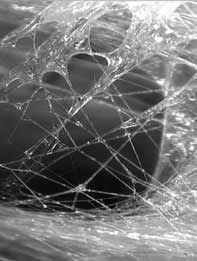How to Care for Your Fascia
 Fascia is our biological fabric that creates our body's form. Fascia surrounds and connects joints, muscles, and organs. Fascia is what holds our bodies together. These interconnected fibers direct and distribute movement forces throughout the body. Fascia is also a sensory organ. Fascia provides us with the sense of proprioception. This allows us to know where we are in space. In fact, fascia consists of six to ten times more sensory nerve receptors than muscles, and is arguably our richest sensory organ.
Fascia is our biological fabric that creates our body's form. Fascia surrounds and connects joints, muscles, and organs. Fascia is what holds our bodies together. These interconnected fibers direct and distribute movement forces throughout the body. Fascia is also a sensory organ. Fascia provides us with the sense of proprioception. This allows us to know where we are in space. In fact, fascia consists of six to ten times more sensory nerve receptors than muscles, and is arguably our richest sensory organ.
Caring for your fascia is important for conditioning healthy bodies. Unfortunately, poor posture, lack of movement as well as repetitive movement can all damage fascia. Our bodies will feel heavy, aged, achy, and lethargic as a result. In fact, chronic overuse injuries are the effect of overloaded, strained fascia. The good news is that fascia is very malleable and incredibly resilient. Fascia will respond and remodel itself to changes in forces. Along with doing Rolfing® Structural Integration here are some other things that you can do to help keep your fascia and body resilient, youthful and vital.
– R. Schleip
Hydrate:
Fascia is made up of about 2/3 water. The fascia in your body will glide, slide and stretch easier with proper hydration.
Move with Variation:
Movement helps to transport liquid through the tissues. Variation of movement prevents adhesions and will ensure even better tissue hydration. If you work in the same position most of the day, take a few minutes at least every couple hours to stretch and move. You could also start a fascial stretching practice. Try dedicating a few minutes each morning to rolling, reaching and stretching your body from head to toe. Consider your habitual movements throughout the day and find ways to vary them. This is important because moving in the same way squeezes so much fluid out of the fascia that it actually dehydrates the tissue, which makes it brittle and sets the stage for macro and micro tears. These all can contribute to a whole range of overuse injuries.
Rest and Relax:
This is when tissues have time to heal. Rest is needed for fascia to have time to rehydrate with fresh fluid after being wrung out from movement. Your body will then be ready for more movement. Be sure to get plenty of sleep and find ways to reduce stress. Yoga and meditation can be used as relaxation techniques to help improve sleep patterns and achieve deeper states of relaxation. Taking a warm Epsom salt bath can also help bring ease to stiff fascia. You may even find it helps to follow that up with a few minutes of light activity to gently mobilize loosened adhesions.
Stretch and Mobilize Tissue:
Rolfing Structural Integration as well as other therapies that release fascial restrictions will help to mobilize restricted tissue. Self-massage with foam rollers as well as massage balls are other options, but should be properly learned. Slow gentle stretching can help lengthen fascia as well.
Play/Exercise Regularly:
When you move, not only do your muscles respond but so does your fascia. Your fascia will become stronger, more elastic, more communicative, and generally more capable. Walking, climbing, running, bouldering, yoga-ing, and swimming are examples of activities to try. Begin slowly and increase these activities gradually. Once your tissues regain more of its natural spring, the recoiling effect of the fascia will allow you to exert less muscle effort, and therefore fatigue less. Want to play harder, jump higher, run faster, reach further or move with more ease? Find ways to cultivate the more fluid, elastic qualities of your fascia. For instance, you may find when you run with healthy fascia the force you transmit into the ground gets returned through the whole tensional network of the fascia. This is not too different from the spring in a gazelle’s leap. So once you’ve done the work to rehydrate your tissue, look to embody more elastic movements. Some other examples of how you can best train stronger more elastic fascia include sprinting, box jumping, and lifting with clubbells, or kettlebells. Martial arts and dance can also help to train this inner spring.
Respect your Body:
Avoid high-impact aerobic activities and weight lifting while injured or in pain. Attempting to train through an injury can cause your fascia to find ways to compensate and eventually, even after the injury has healed, your fascia may still support the dysfunctional movement pattern. This can perpetuate the injury cycle. If training proceeds too fast, too hard, or without variation, then the fascia may respond by forming adhesion, stiffening, limiting its versatility and ultimately leading to more injury. It's best to take some extra time to build up then to set yourself up for long-term trouble.
Patience:
Forming an entirely, new, more vital, resilient, elastic, communicative, responsive fascia-body can take any where from 6 to 24 months. Find ways to enjoy the process and your body will thank you.
Robert Schleip et al., Fascia: In Sport and Movement (2014).
Joanne Avison,. Yoga: Fascia Anatomy and Movement (2015).
J.C. Guimberteau, “The Sliding Mechanics of the Subcutaneous Structures in Man Illustration of a Functional Unit: The Microvacuoles,” Studies of the Académie Nationale de Chuirurgie (2005).
Robert Schleip et al., Fascia: The Tensional Network of the Human Body (2012).


